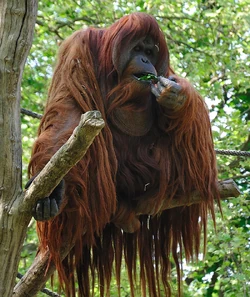| Bornean Orangutan | |
|---|---|
 Male | |
| Information | |
| Range | Borneo |
| Scientific Classification | |
| Kingdom | Animalia |
| Phylum | Chordata |
| Class | Mammalia |
| Order | Primates |
| Family | Hominidae |
| Genus | Pongo |
| Species | Pongo pygmaeus |
| Conservation Status | |
 Critically Endangered | |
The Bornean Orangutan, (Pongo pygmaeus), is a species of orangutan native to the island of Borneo. Together with the sumatran orangutan, it belongs to the only genus of great apes native to Asia. Like the other great apes, orangutans are highly intelligent, displaying advanced tool use and distinct cultural patterns in the wild. Orangutans share approximately 97% of their DNA with humans.
The Bornean orangutan is an endangered species, with deforestation, palm oil plantations and hunting posing a serious threat to its continued existence.
Habitat and Distribution[]
The Bornean orangutan lives in tropical and subtropical moist broadleaf forests in the Bornean lowlands, as well as mountainous areas up to 1,500 metres (4,900 ft) above sea level. This species lives throughout the canopy of primary and secondary forests, and moves large distances to find trees bearing fruit.
It can be found in the two Malaysian states of Sabah and Sarawak, and three of the four Indonesian Provinces of Kalimantan. Due to habitat destruction, the species distribution is now highly patchy throughout the island; the species has become rare in the southeast of the island, as well as in the forests between the Rejang River in central Sarawak and the Padas River in western Sabah.
Behavior and Ecology[]
In history, orangutans ranged throughout Southeast Asia and into southern China, as well as on the island of Java and in southern Sumatra. They primarily inhabit peat swamp forests, tropical health forests, and mixed dipterocarp forests.
Bornean orangutan are more solitary than their Sumatran relatives. Two or three orangutans with overlapping territories may interact, but only for short periods of time. Although orangutans are not territorial, adult males will display threatening behaviors upon meeting other males, and only socialize with females to mate. Males are considered the most solitary of the orangutans. The Bornean orangutan has a lifespan of 35–45 years in the wild; in captivity it can live to be about 60. Orangutans are strong, intellegent creatures. For example, they swing from vines and certain orangutan groups use leaves as napkins. When an orangutan has sore muscles, they chew leaves into a mushy paste. Then, they apply this mushy paste to the sore. Mother orangutans teach baby orangutans which plants are poisonus and which plants are not.
Despite being arboreal, the Bornean orangutan travels on the ground more than its Sumatran counterpart. This may be in part because no large terrestrial predators could threaten an orangutan in Borneo. In Sumatra, orangutans must face predation by the fierce sumatran tiger.
Diet[]
The Bornean orangutan diet is composed of over 400 types of food, including wild figs, durians, leaves, seeds, bird eggs, flowers, honey, insects, and, to a lesser extent than the Sumatran orangutan, bark. They have also been known to consume the inner shoots of plants and vines. They get the necessary quantities of water from both fruit and from tree holes.
Bornean orangutans have been sighted using spears to catch fish. The species has been observed using tools such as leaves to wipe off faeces, a pad of leaves for holding spiny durian fruit, a leafy branch for a bee swatter, a bunch of leafy branches held together as an "umbrella" while traveling in the rain, a single stick as backscratcher, and a branch or tree trunk as a missile. And in other regions, orangutans occasionally eat soil to get minerals that may neutralize the toxins and acids they consume in their primarily vegetarian diets. On rare occasions, orangutans will prey upon other, smaller primates, such as slow lorises.
Reproduction[]
 |
 |
 |
Males and females generally come together only to mate. Subadult males (unflanged) will try to mate with any female and will be successful around half the time. Dominant flanged males will call and advertise their position to receptive females, who prefer mating with flanged males. Adult males will often target females with weaned infants as mating partners because the female is likely to be fertile.
Females reach sexual maturity and experience their first ovulatory cycle between about six and 11 years of age, although females with more body fat may experience this at an earlier age. The estrous cycle lasts between 22 and 30 days and menopause has been reported in captive orangutans at about age 48. Females tend to give birth at about 14–15 years of age. Newborn orangutans nurse every three to four hours, and begin to take soft food from their mothers' lips by four months. During the first year of its life, the young clings to its mother's abdomen by entwining its fingers in and gripping her fur. Offspring are weaned at about four years, but this could be much longer, and soon after they start their adolescent stage of exploring, but always within sight of their mother. During this period, they will also actively seek other young orangutans to play with and travel with.
A 2011 study on female orangutans in free-ranging rehabilitation programs found that individuals that were supplemented with food resources had shorter interbirth intervals, as well as a reduced age, at first birth.








